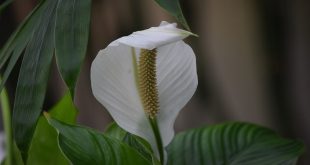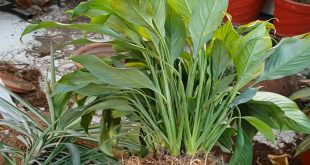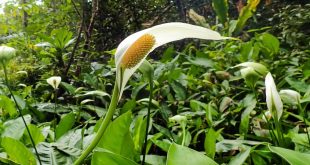The peace lily leaves turn brown due to overwatering or exposure to direct sunlight. Peace lilies are prone to browning leaves if not cared for correctly, so it is important to provide the right amount of water and light for optimal growth.
Overwatering can lead to root rot, causing the leaves to turn brown, while direct sunlight can scorch the leaves. Proper watering techniques, such as allowing the soil to dry out between waterings, and placing the plant in a location with bright, indirect light will help maintain healthy green leaves.
Regularly wiping the leaves with a damp cloth can also prevent dust buildup, which can contribute to browning. By following these guidelines, you can keep your peace lily looking vibrant and healthy.
Common Causes Of Brown Peace Lily Leaves
Overwatering:
- Overwatering is one of the most common causes of brown peace lily leaves.
- When you water your peace lily excessively, the roots become waterlogged and oxygen-starved, leading to root rot.
- This can result in the browning of the leaves, as the plant is unable to take up nutrients properly.
- Signs of overwatering include yellowing of lower leaves, wilting, and a foul odor coming from the soil.
Underwatering:
- Underwatering is another common reason behind brown peace lily leaves.
- When you don’t provide enough water to your peace lily, the plant becomes stressed and enters a survival mode.
- As a defense mechanism, the plant starts to shed its older leaves, resulting in brown discoloration.
- Signs of underwatering include drooping leaves, dry soil, and a generally weakened appearance.
Low humidity:
- Peace lilies thrive in high humidity environments, so low humidity levels can lead to browning of their leaves.
- In low humidity conditions, the plant loses moisture through the leaves at a faster rate, causing the edges to brown.
- Brown spots and tips on the leaves are indicative of low humidity problems.
- You can increase humidity levels by placing the plant near a humidifier, grouping it with other plants, or using a pebble tray filled with water.
Direct sunlight exposure:
- Peace lilies prefer bright, indirect light, and direct sunlight exposure can cause their leaves to turn brown.
- Intense sunlight can scorch the leaves, resulting in browning and even sunburn.
- If your peace lily is receiving too much direct light, you may notice browning on the side of the plant facing the window.
- Move your peace lily to a location with filtered or diffused light to prevent further browning.
Remember, it’s important to address the underlying causes of brown peace lily leaves to ensure the plant’s health and vitality. By properly adjusting watering routines, managing humidity levels, and providing suitable lighting conditions, you can help your peace lily thrive and maintain its lush green foliage.
How To Identify Overwatering In Peace Lilies
Are you noticing brown leaves on your peace lily? Don’t panic! This common issue can be easily resolved once you understand the root cause. Overwatering is one of the main culprits behind brown leaves in peace lilies. By learning how to identify overwatering in your plants, you can take the necessary steps to keep them healthy and vibrant.
Drooping Leaves:
- One of the signs of overwatering in peace lilies is drooping leaves.
- The leaves may appear limp and wilted, losing their characteristic upright posture.
- If you notice that your peace lily’s leaves are drooping, it’s a strong indication that excess moisture is hampering the plant’s health.
Yellowing Leaves:
- Overwatering can also cause the leaves of peace lilies to turn yellow.
- When the plant receives more water than it can process, it disrupts the balance of nutrients in the soil, leading to nutrient deficiency.
- As a result, the leaves start yellowing from the tips and then gradually progress towards the center of the leaf.
Mushy Stems:
- Another telltale sign of overwatered peace lilies is mushy stems.
- When the plant is consistently exposed to excess moisture, the stems become soft and squishy.
- This happens because the roots are suffocating and unable to absorb oxygen properly, leading to the weakening of stems.
Foul Odor:
- Overwatering often leads to root rot, which emits a foul odor.
- If you notice a musty or rotting smell coming from your peace lily, it’s a clear indication that the roots are decaying due to excessive watering.
- This can further contribute to browning of leaves and the overall decline of the plant’s health.
To prevent overwatering, it’s important to establish a proper watering routine. Allow the top inch of the soil to dry out before watering again. Additionally, ensure that the pot has proper drainage to allow excess water to escape. By addressing the issue of overwatering, you can save your peace lily from further damage and enjoy its lush green foliage once again.
Techniques For Properly Watering Peace Lilies
A healthy peace lily can be a beautiful addition to your indoor space, but it can be quite disheartening to see its once lush green leaves turning brown. One of the most common reasons for this browning is improper watering.
Understanding the techniques for properly watering peace lilies is crucial to ensure their health and longevity. In this section, we will explore three key aspects of watering peace lilies: assessing soil moisture levels, using the right watering technique, and establishing a watering schedule.
Assessing Soil Moisture Levels:
- Before watering your peace lily, it’s essential to assess the moisture level of the soil.
- Stick your finger about an inch into the soil; if it feels dry, your peace lily likely needs watering.
- However, if the soil feels moist or wet, it’s best to hold off on watering as overwatering can lead to root rot and brown leaves.
Using The Right Watering Technique:
- When it’s time to water, use room temperature water to prevent shocking the plant.
- Pour water slowly and evenly onto the soil until it starts to drain out from the bottom of the pot.
- Avoid letting your peace lily sit in stagnant water, as this can lead to root problems.
- If your peace lily is in a decorative container without drainage holes, be cautious not to overwater or consider using a smaller plastic nursery pot with drainage that fits inside the decorative container.
Establishing A Watering Schedule:
- Peace lilies generally prefer slightly moist soil but can tolerate a bit of drought between waterings.
- A general rule of thumb is to water your peace lily when the top inch of the soil feels dry to the touch.
- However, avoid waiting until the plant starts showing signs of stress, such as wilting or yellowing leaves, before watering.
- Depending on factors like humidity, temperature, and the size of the pot, you may need to adjust the watering frequency accordingly.
Properly watering your peace lilies is crucial for their overall wellbeing. By assessing soil moisture levels, using the right watering technique, and establishing a watering schedule, you can help prevent those dreaded brown leaves and keep your peace lilies thriving in their indoor oasis.
Remember to always observe your plant’s behavior and adjust your watering practices accordingly to ensure the best care possible.
The Effects Of Underwatering On Peace Lilies
With their lush green leaves and delicate white flowers, peace lilies are a popular choice for indoor gardening enthusiasts. However, if you notice your peace lily’s leaves turning brown, it could be a sign that something is amiss. One of the most common causes of browning leaves in peace lilies is underwatering.
Let’s dive deeper into the effects of underwatering on peace lilies.
Wilting Leaves:
- Peace lilies have a high water requirement and are sensitive to drying out.
- When a peace lily is underwatered, its leaves will begin to wilt and appear droopy.
- This wilting is the plant’s way of conserving water in its root system.
Dry Soil:
- Underwatering leads to soil drying out faster than usual.
- You can check if the soil is dry by inserting your finger about an inch into the soil.
- If the soil feels dry, it’s a clear indication that your peace lily needs watering.
Stunted Growth:
- Peace lilies rely on a steady supply of water for healthy growth.
- When they lack water, their growth can become stunted.
- The plant’s energy is diverted from growing and producing new leaves to conserving existing resources.
Remember, while it may be tempting to overwater your peace lily to remedy the browning leaves, this can actually cause more harm than good. It’s best to water your peace lily when the soil feels dry, ensuring it has enough water to thrive without becoming waterlogged.
By paying attention to the watering needs of your peace lily, you can keep its leaves vibrant and enjoy the beauty it brings to your indoor space.
Providing Adequate Humidity For Peace Lilies
Peace lilies are popular indoor plants with lush green leaves and elegant white blooms. However, if you notice your peace lily leaves turning brown, it could be a sign that it is not getting enough humidity. These tropical beauties thrive in high humidity environments, similar to their natural habitat in the rainforests.
To help your peace lily flourish and prevent browning of its leaves, here are a few tips for providing the adequate humidity it craves:
Using A Humidifier
- Invest in a humidifier: One of the most effective ways to increase humidity levels is by using a humidifier. Set up a humidifier near your peace lily to maintain moisture in the air.
- Follow the right humidity levels: Aim for a humidity level of around 50 to 60 percent, which mimics the tropical conditions these plants thrive in.
- Monitor and adjust: Regularly check the humidity levels in the room using a hygrometer. If the air is too dry, increase the humidity by adjusting the settings on your humidifier.
Grouping Plants Together
- Create a mini greenhouse: Positioning your peace lily alongside other indoor plants can create a microclimate that retains moisture. The moisture released by the plants’ transpiration process will benefit all the plants involved.
- Choose suitable plant companions: Select plants that also require high humidity, such as ferns or orchids, to create an ideal environment for your peace lily.
- Ensure adequate spacing: While grouping plants together can increase humidity, be sure to provide enough space for each plant to receive adequate airflow and light.
Misting The Leaves
- Water via misting: Occasionally misting the leaves of your peace lily can help boost humidity levels. Use room temperature water to avoid shocking the plant and gently mist the foliage, ensuring that each leaf gets a light coating of water.
- Avoid over-misting: Be mindful not to over-mist as excessive moisture on the leaves can lead to disease or pest problems. Aim for light misting once or twice a week.
- Mist during dry seasons: Increase misting during dry seasons or if the indoor environment tends to be particularly dry, such as during winter months when heating systems are in use.
Remember, providing adequate humidity is crucial for maintaining the health and vibrant appearance of your peace lily. By using a humidifier, grouping plants together, and misting the leaves, you can create a suitable environment that mimics the tropical conditions these plants thrive in.
So, keep an eye on the humidity levels and offer your peace lily the moisture it needs to keep those leaves lush and green.
The Relationship Between Direct Sunlight And Brown Leaves
If you’ve noticed your peace lily’s once vibrant green leaves turning brown, there could be several factors at play. One of the most common causes is direct sunlight, which can lead to sunburned leaves. Understanding the relationship between sunlight and the browning of your peace lily leaves can help you address the issue effectively.
Let’s explore this further under the subheading: the relationship between direct sunlight and brown leaves.
Sunburned Leaves:
- Direct sunlight can be harsh for peace lilies, especially during the hottest parts of the day.
- The intense rays from the sun can cause sunburn, leading to brown patches or spots on the leaves.
- Sunburned leaves may appear discolored, dry, or scorched, and the browning often starts at the edges and spreads inward.
- When exposed to direct sunlight for extended periods, the leaves may suffer irreparable damage.
Light Intensity And Duration:
- Peace lilies prefer bright, indirect light, making them well-suited for indoor spaces away from direct sunlight.
- If your peace lily is placed too close to a window or receives a high intensity of light, it can result in sunburned leaves.
- The duration of sunlight exposure also plays a role. Even short periods of intense sunlight can lead to leaf browning over time.
- Consider adjusting the location of your peace lily to a spot with less direct sunlight or diffusing the light with curtains or blinds.
Proper Placement In Indoor Spaces:
- When placing your peace lily indoors, ensure it is in a location where it receives ample but indirect light.
- Find a balance between light and shade to prevent excessive exposure and subsequent leaf browning.
- Avoid placing your peace lily near heat sources like radiators, as they can intensify the effects of sunlight and dry out the leaves.
- If you notice your peace lily’s leaves turning brown, try moving it to a different spot with softer, filtered light.
Remember, while peace lilies enjoy light, they thrive in conditions with fewer harsh rays. By understanding the relationship between direct sunlight and brown leaves, you can properly care for your peace lily and help it retain its lush green appearance.
How To Prevent And Treat Brown Peace Lily Leaves
Your peace lily is a beautiful, lush plant that adds a touch of elegance to any space. However, if you’ve noticed that its leaves are turning brown, it’s a sign that something isn’t quite right. Brown peace lily leaves can be caused by a few different factors, but luckily there are steps you can take to prevent and treat this issue.
Let’s explore some effective methods to keep your peace lily looking vibrant and healthy.
Adjusting Watering Practices
Ensure that you are not overwatering your peace lily. Overwatering can lead to root rot and brown leaves. Follow these tips to adjust your watering practices:
- Allow the top inch of soil to dry out before watering again.
- Use your finger to check the moisture level in the soil. If it feels dry, it’s time to water.
- Water your peace lily thoroughly until the excess water drains out of the bottom of the pot.
Increasing Humidity Levels
Peace lilies thrive in high humidity environments, so low humidity can cause their leaves to turn brown. Consider these methods to increase humidity around your plant:
- Place a tray filled with water near your peace lily to create a humid microclimate.
- Group your houseplants together, as they release moisture through transpiration, creating a more humid environment.
- Mist the leaves of your peace lily regularly with room-temperature water. This will help replicate their natural habitat.
Providing Adequate Shade
While peace lilies enjoy bright, indirect light, too much direct sunlight can scorch their leaves, causing them to turn brown. Here’s how you can provide the right amount of shade:
- Keep your peace lily away from windows with direct sunlight, or use sheer curtains to filter the light.
- If you notice brown spots on the leaves, it may be a sign that the plant is getting too much sun. Move it to a shadier location to prevent further leaf damage.
Pruning Damaged Leaves
Pruning damaged leaves is essential to maintain the health and appearance of your peace lily. Follow these steps when pruning:
- Use clean, sharp pruning shears or scissors to remove brown leaves. Make sure to disinfect the tools to prevent the spread of any diseases or pests.
- Cut the brown leaf off at its base, near the soil level.
- Avoid cutting healthy green leaves, even if they have some browning on the tips. This is usually normal and doesn’t require pruning.
By adjusting your watering practices, increasing humidity levels, providing adequate shade, and pruning damaged leaves, you can effectively prevent and treat brown peace lily leaves. With a little care and attention, your peace lily will regain its vibrancy and continue to beautify your home or office.
Frequently Asked Questions For Why Are Your Peace Lily Leaves Turning Brown?
Why Are My Peace Lily Leaves Turning Brown?
Peace lily leaves can turn brown due to several reasons such as overwatering, underwatering, exposure to direct sunlight, or dry air. It could also indicate pest infestation or nutrient deficiency. Proper care, including regular watering, indirect light, and a humidity tray, can help prevent browning leaves.
How Do I Know If My Peace Lily Is Getting Too Much Water?
An overwatered peace lily may start showing signs such as yellowing leaves, wilting despite moist soil, and the presence of root rot. To avoid overwatering, ensure the top inch of soil is dry before watering again. It’s better to underwater slightly than to keep the soil constantly wet.
What Should I Do If My Peace Lily Leaves Turn Completely Brown?
If your peace lily leaves turn completely brown, it’s best to remove them. Cut the stem close to the base without damaging the healthy leaves. This will not only improve the plant’s appearance but also prevent the spread of any diseases or pests that may be affecting the plant.
Can My Peace Lily Recover From Brown Leaves?
Yes, your peace lily can recover from brown leaves with proper care. Identify the cause of browning and address the issue accordingly. Providing the right amount of water, indirect light, and humidity can stimulate new growth and healthy leaves over time.
How Do I Increase Humidity For My Peace Lily?
Increasing humidity for your peace lily can be achieved through simple methods such as placing the pot on a tray of water and pebbles or using a humidifier nearby. Grouping plants together or misting the leaves with water can also create a more humid environment.
Can Brown Peace Lily Leaves Be A Sign Of Plant Disease?
Yes, brown peace lily leaves can be a sign of plant diseases such as bacterial or fungal infections. If you suspect a disease, isolate the plant from other healthy ones and treat it with appropriate fungicides or bactericides. It’s crucial to follow the instructions carefully and ensure good ventilation to prevent further spread.
Conclusion
To summarize, it is essential to understand the common causes of brown leaves on your peace lily in order to effectively treat and prevent this issue. Overwatering, underwatering, inadequate lighting, and low humidity levels are common culprits that can trigger browning.
By ensuring you provide the right balance of watering, light, and humidity, you can help your peace lily thrive. Regularly inspect the leaves for signs of pests or diseases, as early detection and treatment are crucial to keeping your plant healthy.
Additionally, maintaining a clean environment and avoiding draughts can also contribute to maintaining vibrant, green foliage. Remember that patience and consistency are key when it comes to caring for your peace lily. With proper attention and care, you can enjoy beautiful, lush foliage that will bring serenity to any space.
 GardenXpert Garden Advice Blog
GardenXpert Garden Advice Blog





